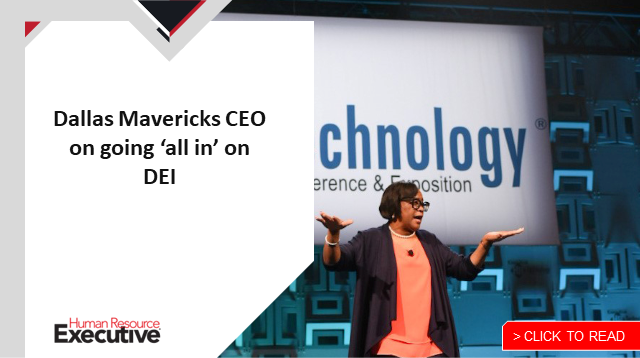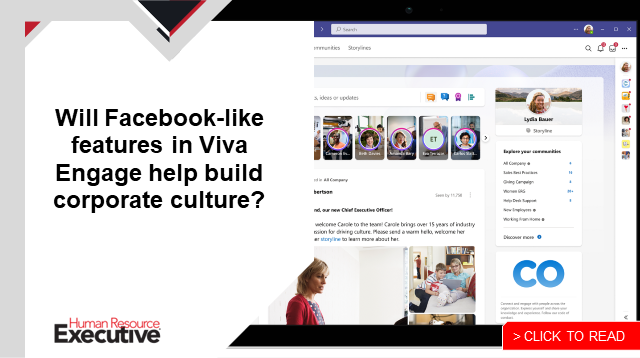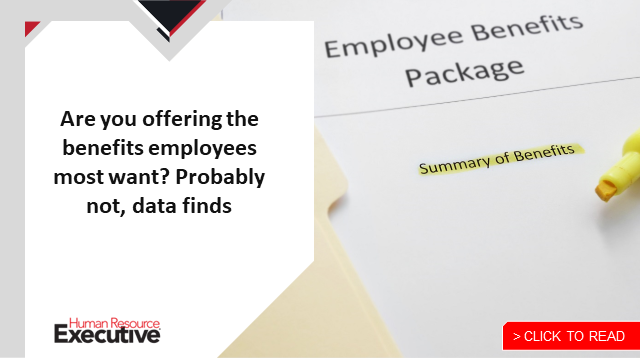Over the last few years, the pandemic has brought about great changes in the workplace and how we do our work. Those changes are reflected in the companies that are Most Admired for HR. Newly eligible Zoom Video Communications cracked the top 20. And Pfizer (co-developer of one of the most effective COVID-19 vaccines) showed big gains in the rankings, along with manufacturers of semiconductors (critical to tools that helped navigate disruptions and will fuel growth in the future). For employees, priorities have shifted, with many placing greater emphasis on health and family. At the same time, there has been a blending of our personal and professional lives. Workers in many roles are no longer confined to a physical office space or work location. Yet, in our always-on culture, there’s an expectation that these same workers are available outside of normal business hours.
One might think that employee engagement (the “want to” of work) and employee enablement (the “can do” of work) would have taken a hit during all this disruption, but a new Korn Ferry analysis shows that the opposite happened. We reviewed data from our global employee opinion database, looking at overall movement of scores as well as shifts over three different phases of the pandemic:
- The “reactive” phase: February 2020-August 2020
- The “empathy” phase: September 2020-May 2021
- The “entrenchment” phase: June 2021-December 2021
This analysis indicated that engagement and enablement actually improved over the span of the pandemic. While organizations may have dodged a bullet, however, these trends are not cause for outright celebration as evidenced by high rates of turnover.
Engagement and enablement scores showed nominal gains during those two years, with a lot of the increases being front-loaded during the reactive phase of the pandemic, where people were happy to have an income. The patterns of scores during the empathy and entrenchment phases were less than decisive. They also suggest that, from the perspective of the employees, the “winner” may have been the companies rather than the individual worker.
Why engagement and enablement
Before going too much further, we should review why this all matters to organizations.
 Engaged employees are committed to the organization and are willing to put in extra effort to get things done. Engaged employees are more energized at work and feel like they are contributing to something larger than themselves. As such, they tend to be more loyal. Engagement can also serve as a coping mechanism, helping employees to deal with the chaos that surrounds them and take actions that align with the company’s priorities, culture and values.
Engaged employees are committed to the organization and are willing to put in extra effort to get things done. Engaged employees are more energized at work and feel like they are contributing to something larger than themselves. As such, they tend to be more loyal. Engagement can also serve as a coping mechanism, helping employees to deal with the chaos that surrounds them and take actions that align with the company’s priorities, culture and values.
But engagement alone isn’t enough. Those same employees need to be enabled to get their jobs done. Enabled employees are those whose skills are fully utilized and work in environments that support high levels of productivity. Through that comes personal, team and organizational effectiveness.
The what and why of shifting engagement and enablement
The reactive phase [February 2020-August 2020]
There is certainly a lot at stake when it comes to engagement and enablement, which is why the early stage of the pandemic—the “reactive” phase—was such a point of concern.
When the pandemic first hit, there was a great deal of uncertainty. Offices closed and businesses suffered. The resulting furloughs and layoffs cast considerable doubt on the future. Organizations were in catch-up mode, reacting to the changes in real time before they could come up with a more comprehensive strategy.
Yet, despite the challenges, engagement and enablement scores went up during this period. These increases may seem counterintuitive, given conditions at the time. There are two ways to explain the results. The first is that engagement and enablement are often lagging indicators, and the scores may not have caught up with the reality of the moment (or people were simply wary of providing negative feedback). A second is that, with all the uncertainty, people were happy to have jobs and reacted positively to their employers’ initial responses, whatever those might have been.
A breakdown of the scores sheds more light on the results and lends support to the latter explanation. The largest increases in scores came on items related to pay, benefits and development opportunities. Employees were more positive about being paid fairly for the work they do, likely reflecting appreciation for preserving their incomes amid furloughs and layoffs. Many employers emphasized benefit options to help employees manage pandemic challenges (e.g., telehealth, emergency childcare), resulting in increased satisfaction with benefits meeting their needs. Additionally, employees saw the development opportunities that change presented, with some devoting slack time to job-related training.
On the enablement side, employees who abruptly moved to working remotely commonly highlighted the productivity benefits of reduced commute times, greater control over their schedules and an increased ability to focus with fewer distractions. Decision-making accelerated as organizations were pressed to respond quickly to new challenges.
At the same time, people had no real sense of what was going on around them. Employees gave lower scores on their understanding of company strategy and compensation policies. Concerns were also registered around physical working conditions (as employees adapted to new work arrangements), workloads (for some, working from home felt more like sleeping in the office), and access to immediate managers for support. Likewise, people were less confident about responsiveness to customers and prospects for company success over the next 2-3 years.
 In short, employees were saying, “It’s a mess, but I’m still here.” That was enough to drive overall gains, some of which carry through to the current period.
In short, employees were saying, “It’s a mess, but I’m still here.” That was enough to drive overall gains, some of which carry through to the current period.
The empathy phase [September 2020-May 2021]
After the reactive phase, most organizations took a 180-degree turn with their approaches. In this next phase, significant effort was placed on being empathetic and supportive. When it came to the work itself, everything was on the table. Longstanding (and often rigid) policies fell by the wayside as organizations tried to make themselves more agile and flexible and help their employees adjust to talking to one another in little boxes on their computers.
One might think this is where we’d see the biggest increase in engagement and enablement scores, but that didn’t happen, as scores remained flat throughout the period.
It’s not that employees didn’t appreciate the effort. Many of the same items that dropped during the reactive phase showed gains. There was a race back to the mean on questions relating to the understanding of policies, trust in immediate managers, organizations showing care and concern for employees, and support from other parts of the company. Scores even improved around perceptions of workloads.
That was all offset by the grim reality of the time. Amid opportunities emerging elsewhere in a strengthening labor market, employees were no longer feeling as good about pay, benefits and training. They were even less upbeat about their companies’ futures or their own opportunities for advancement. It was here that the roots of the “great resignation” likely began to take hold.
The entrenchment phase, a breakdown of trust [June 2021-December 2021]
More than a year into the pandemic, conditions started to normalize. The things that had been put in place in response had become part of the fabric of the organization. Organizations were also talking about bringing people back to the office—either full time or as part of some hybrid structure.
Engagement and enablement scores ticked up slightly during this time, perhaps on the hope that the worst of the pandemic was over. However, that was not enough to keep people in their jobs. This was the first period where there was a drop in how long people planned to continue working for their companies, after increases during the reactive and empathy phases.
 The problem during this period is that people were feeling better about the state of the companies they worked for than about their own positions. Large gains were evident during the entrenchment phase on confidence in the way companies were managed, their responses to changes in the business environment and their prospects for emerging from the pandemic successfully (a radical departure from previous periods).
The problem during this period is that people were feeling better about the state of the companies they worked for than about their own positions. Large gains were evident during the entrenchment phase on confidence in the way companies were managed, their responses to changes in the business environment and their prospects for emerging from the pandemic successfully (a radical departure from previous periods).
What fell during the entrenchment phase (in addition to the retention outlook) was also telling. Despite increased listening efforts in many companies, people didn’t feel like action was being taken in response to their feedback. There were also issues raised related to fairness and safety. Both findings suggest issues around trust, which should be seen as a major red flag for employers.
Organizations are often accused of taking care of themselves in a crisis, to the exclusion or even the detriment of their employees. Continued gains in perceptions of the care and concern shown for employees suggests we may not have hit that extreme. However, there is work that remains for organizations to keep their people motivated, committed and well-positioned for success.
What’s next
To this point, we’ve talked about the movement in scores from the reactive to empathy to entrenchment phase. Looking beyond the nominal engagement and enablement scores may help chart a path to future success.
Korn Ferry focuses on multiple topics that drive engagement and enablement. Coming out of the entrenchment phase, the stronger categories all related to what the company does (e.g., quality and customer focus) and where the company is headed in the future (e.g., clear and promising direction, confidence in leaders). Organizations also scored relatively well on how work is evaluated and acknowledged (e.g., respect and recognition, performance management).
The lower-scoring categories speak to the employee value proposition (e.g., pay and benefits, development opportunities, training) and how work gets done (e.g., collaboration; work, structure and process; authority and empowerment).
 These latter factors tend to be more personal and differentiated and, therefore, have a large impact on stay or go decisions. Organizations have already started to pick up on the concerns, adding new or enhanced elements to their employee value propositions and looking into different ways of working.
These latter factors tend to be more personal and differentiated and, therefore, have a large impact on stay or go decisions. Organizations have already started to pick up on the concerns, adding new or enhanced elements to their employee value propositions and looking into different ways of working.
Where else should the focus be now? At a minimum, leaders need to ensure that they are listening to their employees and acting on their input. As long as scores remain low and continue to decline in that area, it will be difficult to sustain employee motivation and support.
Additionally, amid pressures to focus on efficiency and performance with looming economic uncertainties, leaders will not want to abandon the empathy many displayed during the pandemic. A continuation of understanding and transparent/personal communications can help sustain the commitment and energy that will be needed to carry through further challenges.
The post The pandemic’s surprising impact on employee engagement and enablement appeared first on HR Executive.